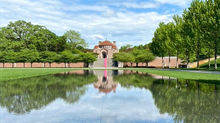Founding Mothers of Minneapolis: Celebrating Early Women Leaders
- markj61
- Mar 2, 2019
- 7 min read
Books about the earliest days of Minneapolis often refer to the “founding fathers” of Minneapolis, but seldom mention the important contributions of women. So this #WomensHistoryMonth, we asked: What were women doing when Minneapolis was a new, developing city?
While many women have contributed to the development of Minneapolis in many unique and inspiring ways, including others featured in our blog, here we tell the stories of four strong and compassionate women now laid to rest at Lakewood — Abby Mendenhall, Harriet Walker, Mahala Pillsbury and Kate Dunwoody — who greatly influenced the growing city by establishing heath care and places to live for those who needed it most. Read their intertwining stories below.

Abby Mendenhall, Harriet Walker, Mahala Pillsbury and Kate Dunwoody
A Place for Young Women with Nowhere to Turn
Abby Mendenhall and her husband Richard were young Quakers from Massachusetts when they arrived in 1858 by steamboat to St. Anthony, piled their belongings on a horse-drawn cart and trekked across the suspension bridge to Minneapolis, their new home.
Richard was a visionary who saw opportunity wherever he looked. Trained as a surveyor, he set about plotting city blocks, buying and selling real estate and establishing a bank. In addition he was fascinated with plants and horticulture, and eventually became one of the city’s first florists.
Abby set about the daunting task of establishing a self-sustaining frontier household that included a vegetable garden and a collection of farm animals. In journal entries for March and April of 1861, she wrote of first chickens hatched, first lamb born, first pigs, first calf, sowing wheat and planting onion sets, making butter — and having company to tea.

Abby Mendenhall, late in life. Source: Hennepin County Library
Eventually Abby had time to look outward. She saw a need: the increasing number of unmarried pregnant girls and women, some on the streets and desperately in need of a home. She found a friend and partner in Harriet Walker. At first glance, they might seem unlikely friends. Harriet had children – eight in all, while Abby had none. But they shared a concern for the lives and health care needs of the women in the city, particularly the poor and unfortunately pregnant with nowhere to turn.
In 1875 they decided to organize, to provide what those women in need needed most. They chose a name, the Sisters of Bethany, and on March 31, 1876, they incorporated. They rented a house on 6th Street, hired a “matron” (house mother) and opened Bethany Home. As the number of residents grew, they hired a superintendent and an assistant, a business “messenger,” and female medical doctors to attend mothers and babies. And the need did grow: over the next 10 years, the group moved Bethany Home to larger quarters six times.
The Sisters’ 1885 Annual Report contained a poignant description of that need: “The little girls who are constantly falling into our hands, or whom we rescue from improper surroundings, and whose number seem to increase as the city grows . . .we do for them what we find necessary to rub off their hearts the doleful scars left by the experiences of their early years.”
These young, single mothers faced economic uncertainty and what was thought to be a lifetime of shame as an unwed mother. The Sisters’ mission was not only to rescue, feed and house, but to provide a base from which the babies could be adopted by others.

Bethany Home nurses. Source: Hennepin County Library
By 1886, the Sisters of Bethany had their own building on Bryant Ave. between 37th and 38th Streets, now the site of the Walker Methodist Health Center. By the 1920s theirs was the oldest women’s organization in the city. On April 21, 1921, the Minneapolis Journal reported that over its 46 years, 8,000 women, chiefly young mothers, had been served by the Sisters of Bethany.
The Bethany Home was renamed Harriet Walker Hospital in 1930, and the mission of serving unwed mothers continued. As late as 1936, property assessments listed the Sisterhood as owner of the hospital property. In 1945, the hospital merged with Elim Home for the Aged and the name was changed to Walker Methodist.

Harriet Walker. Source: Hennepin County Library
A Place for Health Care in a Growing City While T. B. Walker was building his lumber business and art collection, his wife Harriet Walker saw a glaring need for health care that served poor women and children, especially immigrants. She wrote, “Malnutrition, diphtheria, TB, typhoid, pneumonia are diseases of disadvantaged lives” and set out to make a difference.
In 1882, she invited 44 Minneapolis women to a meeting, a social event that turned out to be a fundraiser. Two doctors, both women, spoke. Dr. Mary Hood described the need for a hospital to treat victims of the conditions Harriet described. Dr. Mary Whetstone spoke of the plight of those with the worst diseases. By the time the meeting was over, the ladies had the funds to start a hospital.
The first building was a small rented house with room for ten patients, two nurses in training, and maids. The need was so great that a year later the hospital moved to a second home, then four years later to a permanent location on the corner of Chicago Avenue and 27th Street, where Abbott Northwestern Hospital now stands. In addition to treating diseases, staff physicians Dr. Hood and Dr. Whetstone gave simple, practical care and advice about diet, cleanliness, and rest at what was named Northwestern Hospital, now part of Abbott Northwestern.

Northwestern Hospital, corner of Chicago Avenue and 27th Street in Minneapolis. Source: Allina Health
Serving the needs of women and children was Harriet Walker’s life mission. She served as president of the hospital from its beginning until 1917, the year she died. In addition, as told earlier, she was key to the success of the Bethany Home for unwed mothers and babies, quietly supporting it from when it began in 1875.
Not only friends, Harriet Walker and Abby Mendenhall were partners in both the Bethany Home and Northwestern Hospital. Abby was a member of the hospital’s board of directors for thirteen years and for six years held the office of vice president.
Together these two women laid the foundation for women’s health care in Minnesota, a tradition of quality and compassion that continues in many organizations, among them Abbott Northwestern’s WomenCare program that includes a birth center.
A Place for Young Working Women to Live While Abby Mendenhall and Harriet Walker were addressing the health care needs of poor women and children, Minnesota’s first lady Mahala Pillsbury and her friend Kate Dunwoody focused on housing. Mahala helped organize the first home for orphaned children in the city, the Society for the Relief of Homeless Children, which became the Children’s Home Society. She was elected president of the society in 1881 and continued to lead it until Cadwallader Washburn’s will provided for another orphans’ home (now the Washburn Center for Children).
Mahala then turned to the housing needs of the hundreds of poor young women flocking to the city to find work. Most often their work was domestic service and they were often housed in cramped quarters in their employers’ homes. Too often they were abused — psychologically, physically and sexually. In The Pillsburys of Minnesota, author Lori Sturtevant wrote that a young domestic worker was often “tossed into the street, where worse dangers awaited.”

Mahala Fisk Pillsbury. Source: Hennepin County Library
Mahala and her husband, by then former governor John Pillsbury, built a boarding house for young women at 819 Second Avenue (just south of where St. Olaf Catholic Church now stands). They turned it over to the Women’s Christian Association, an organization whose primary focus was low-cost housing for working women. Mahala had been a member since the WCA’s founding in 1866, and the building was named Mahala Fisk Pillsbury Home for Young Women, later called the Pillsbury Club.

The Pillsbury Club. Source: Hennepin County Library
Kate Dunwoody was also a champion of working young women. She and her husband, William, a flour merchant, came to Minneapolis from Pennsylvania in 1869. William became a rising star in Washburn-Crosby Milling Company, which later became General Mills.
One hundred fifty years later, the Dunwoody name is better known for Kate and William’s philanthropy. Founding what is now Dunwoody College with $4.5 million is perhaps their best-known investment. Kate had a hand in making sure that the college was “free to the youth of the city of Minneapolis and the state of Minnesota without distinction on account of race, color or religious prejudice.”

Kate Dunwoody. Source: AFP Minnesota.
Kate’s interest in the plight of young single working women led the couple to donate their first home, on 10th Street for use as a dormitory. It became known as Kate Dunwoody Hall and housed single working women for 84 years. Together, the Dunwoodys supported both the YWCA and the YMCA and helped start Abbott Hospital. (The original Abbott Hospital building is on the National Register of Historic Places.) Kate likely influenced the couple’s gift of a million dollars to the Minneapolis Institute of Art. Thousands of works have been purchased with Dunwoody funds, and at her death Kate gave the Institute (now Mia) their personal art collection.

Kate Dunwoody Hall. Source: Minnesota Historical Society
All four of these women — and countless others — brought compassion, intelligence, and organizing power to significantly contribute to the progressive city Minneapolis is today.
Learn about more amazing women by following us on Facebook or in one of our other blog stories below.
Read more about women in Minnesota history
Sources:
Sisters of Bethany annual reports; Abby Mendenhall journal; Hennepin County Library Special Collections
Lori Sturdevant, The Pillsburys of Minnesota and Lynn Weiner, "Our Sister's Keepers": The Minneapolis Woman's Christian Association and Housing for Working Women,” Minnesota History, Spring 1979.













































Commentaires